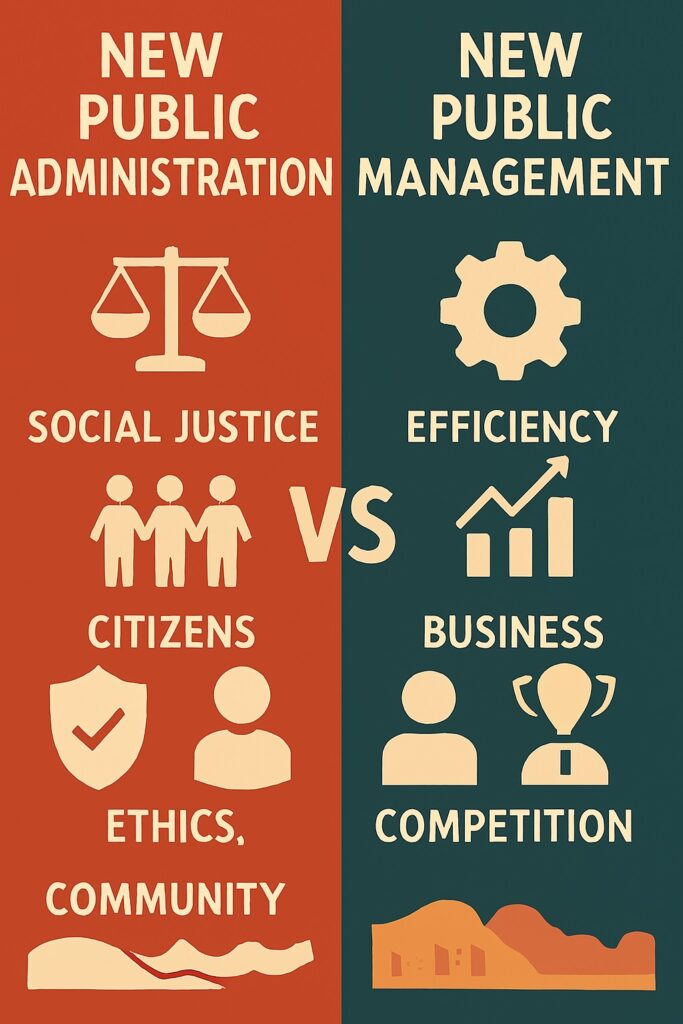How is New Public Administration different from New Public Management? New Public Administration (NPA) and New Public Management (NPM) are two distinct paradigms in the field of public administration, each with its own principles and approaches.

Table of Contents
New Public Administration (NPA)
- Emergence: Developed in the late 1960s and 1970s as a response to social unrest and the perceived inefficiency of traditional bureaucratic systems.
- Key Focus: Emphasizes equity, social justice, and responsiveness in public administration. It seeks to address societal issues and promote citizen welfare rather than mere efficiency.
- Theoretical Basis: Influenced by public policy analysis, political science, and human-centered administration.
- Approach: Advocates administrative discretion, citizen participation, and sensitivity to social problems.
- Criticism: Sometimes seen as overly idealistic, with challenges in practical implementation.
New Public Management (NPM)
- Emergence: Became popular in the 1980s and 1990s, driven by economic pressures and demands for government efficiency.
- Key Focus: Introduces private-sector management techniques into public administration, emphasizing performance, accountability, and cost-effectiveness.
- Theoretical Basis: Draws from business administration, managerial economics, and neoliberal principles.
- Approach: Advocates decentralization, outsourcing, performance-based management, and customer-oriented services.
- Criticism: Sometimes seen as overly focused on efficiency at the expense of social equity.
How is New Public Administration different from New Public Management?
Orientation
- New Public Administration (NPA): NPA emerged in the 1960s and 1970s as a reaction against traditional public administration. It emphasizes social equity, public service values, and the idea that public administration should be oriented toward the public interest and social justice. NPA advocates for a more humane and people-centered approach to governance.
- New Public Management (NPM): NPM gained prominence in the 1980s and 1990s, influenced by ideas from the private sector. It emphasizes market-oriented principles, efficiency, cost-effectiveness, and a business-like approach to public administration. NPM focuses on managerial and performance-oriented reforms.
Values and Goals
- NPA: NPA places a strong emphasis on public service values, ethics, and the pursuit of social justice. It seeks to address societal inequalities and promote the well-being of marginalized groups. NPA advocates for a more responsive and accountable government.
- NPM: NPM is driven by values of efficiency, effectiveness, and customer satisfaction. It aims to enhance the delivery of public services by introducing market mechanisms, competition, and performance measurement. NPM prioritizes results and outcomes over bureaucratic processes.
Role of Government
- NPA: NPA envisions a proactive and interventionist role for government. It believes that government should play a central role in addressing societal issues, including poverty, inequality, and social welfare. NPA advocates for government as a catalyst for social change.
- NPM: NPM advocates for a more limited and streamlined role for government. It promotes privatization, outsourcing, and deregulation to reduce the size and scope of government. NPM emphasizes the need for government to function more like a business entity.
Management Approach
- NPA: NPA is critical of hierarchical and authoritarian management styles. It emphasizes participatory decision-making, collaboration, and empowerment of public servants. NPA supports a more flexible and adaptive approach to management.
- NPM: NPM promotes a results-oriented and performance-driven management style. It encourages performance measurement, accountability, and the use of market-based incentives to motivate public servants. NPM values managerial autonomy and flexibility.
Accountability
- NPA: NPA stresses the importance of accountability to the public and a focus on the common good. It advocates for transparency in decision-making and a strong emphasis on ethical behavior by public officials.
- NPM: NPM emphasizes accountability through performance measurement and market mechanisms. It relies on mechanisms such as contracts and competition to ensure accountability. NPM may prioritize efficiency over equity.
In summary, New Public Administration (NPA) and New Public Management (NPM) represent contrasting paradigms within public administration. NPA prioritizes social equity, ethics, and government intervention in addressing societal issues, while NPM emphasizes efficiency, market-oriented reforms, and a more business-like approach to governance. The choice between these paradigms often depends on the specific goals and values of a government or public organization.